Kantian and Utilitarian Perspectives on Workplace Discrimination
VerifiedAdded on 2023/06/14
|9
|1826
|128
Essay
AI Summary
This essay provides a comprehensive ethical analysis of positive discrimination in the workplace, utilizing both Kantian and Utilitarian philosophical frameworks. The Kantian perspective argues against discrimination due to its violation of moral duties and the potential disruption of workplace decorum, emphasizing adherence to legal and ethical obligations. The Utilitarian perspective, focusing on maximizing overall well-being, also generally opposes discrimination unless it demonstrably leads to greater happiness for a larger number of stakeholders. The essay delves into the nuances of Utilitarianism, contrasting Bentham's quantitative approach to happiness with Mill's qualitative considerations, and examines stakeholder theory. It also addresses the potential negative consequences of utilitarian approaches in certain scenarios, such as immigration policies. The essay concludes by evaluating the limitations and strengths of both Kantian and Utilitarian analyses in the context of workplace ethics, referencing scholarly sources and ethical principles.
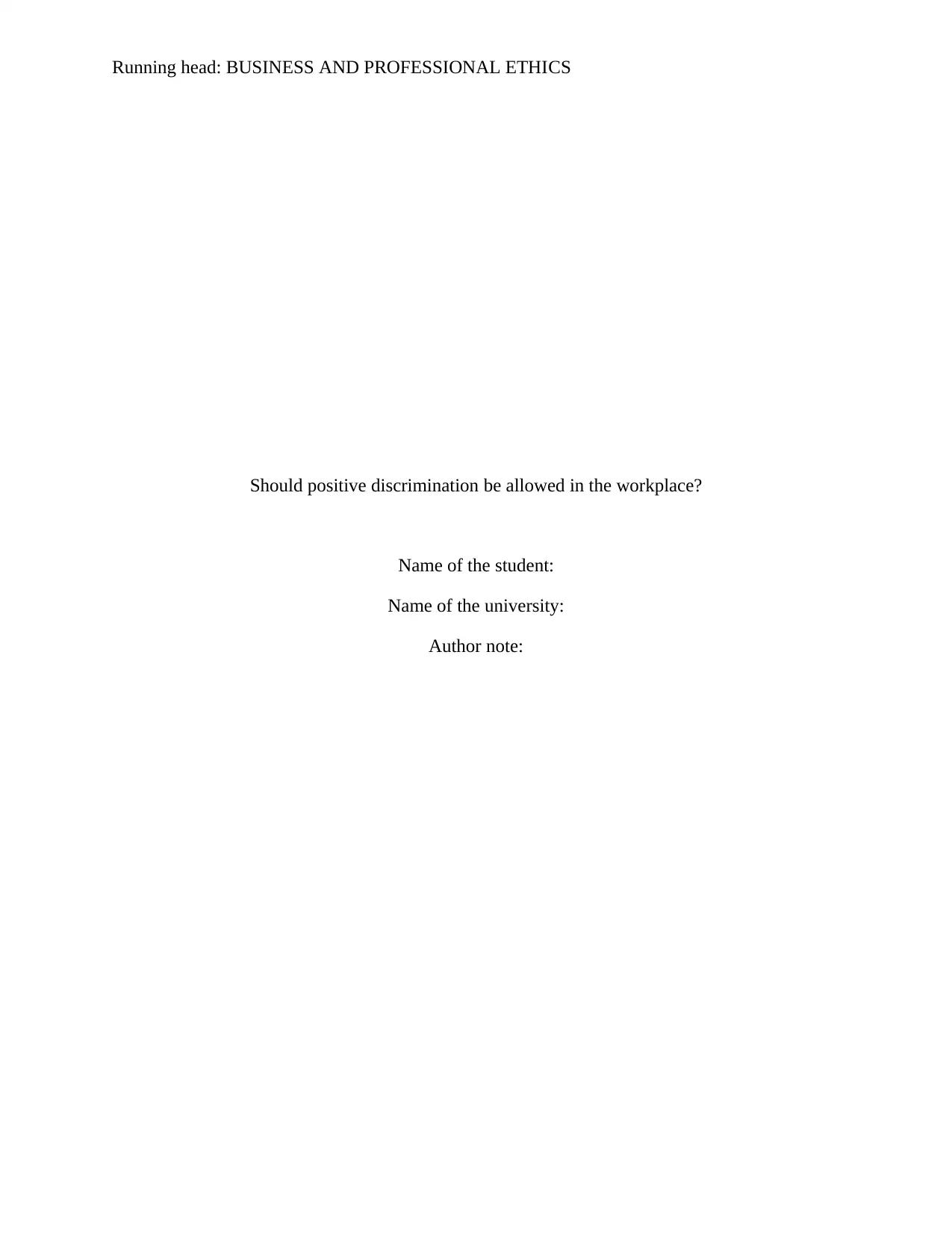
Running head: BUSINESS AND PROFESSIONAL ETHICS
Should positive discrimination be allowed in the workplace?
Name of the student:
Name of the university:
Author note:
Should positive discrimination be allowed in the workplace?
Name of the student:
Name of the university:
Author note:
Paraphrase This Document
Need a fresh take? Get an instant paraphrase of this document with our AI Paraphraser
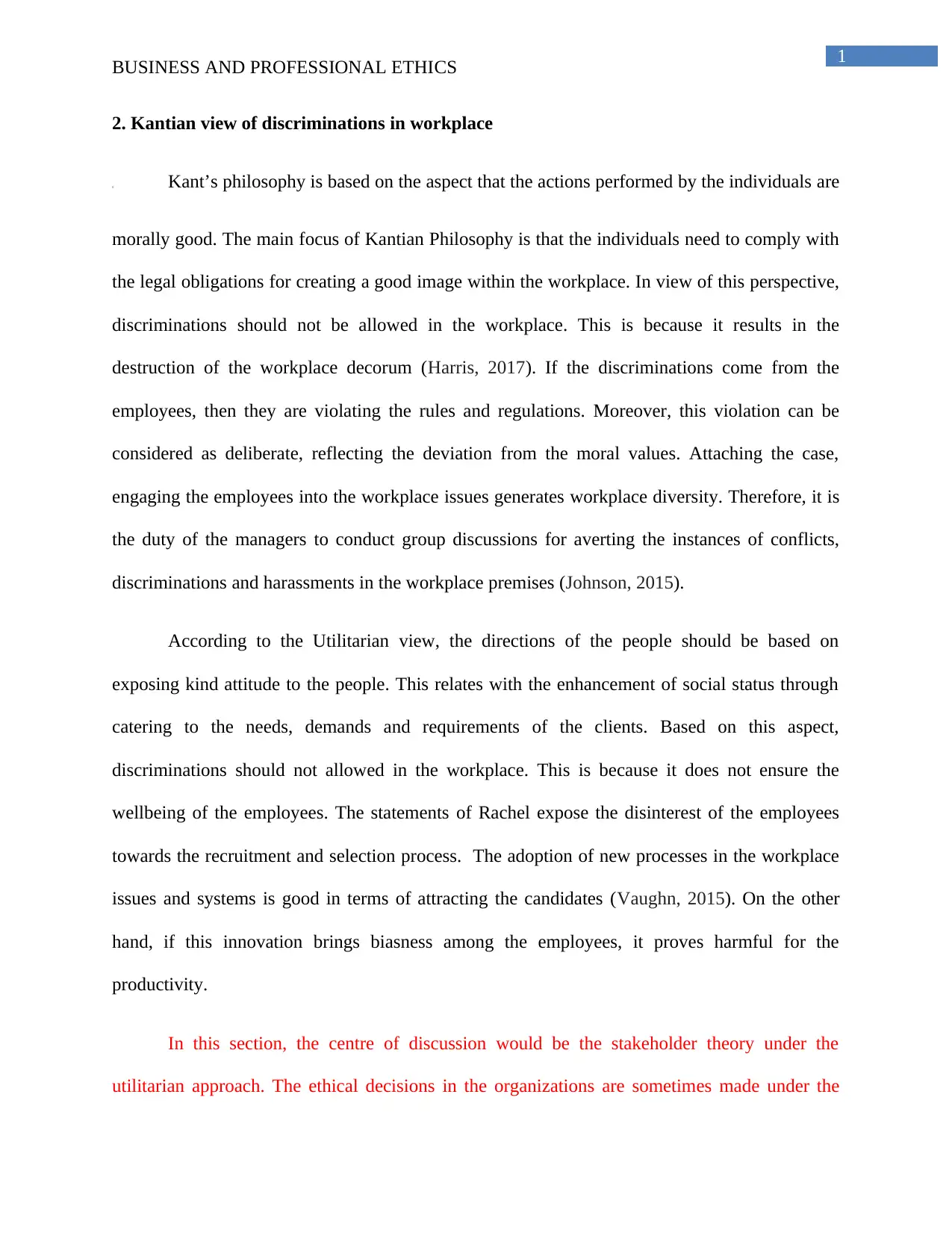
1
BUSINESS AND PROFESSIONAL ETHICS
2. Kantian view of discriminations in workplace
Kant’s philosophy is based on the aspect that the actions performed by the individuals are
morally good. The main focus of Kantian Philosophy is that the individuals need to comply with
the legal obligations for creating a good image within the workplace. In view of this perspective,
discriminations should not be allowed in the workplace. This is because it results in the
destruction of the workplace decorum (Harris, 2017). If the discriminations come from the
employees, then they are violating the rules and regulations. Moreover, this violation can be
considered as deliberate, reflecting the deviation from the moral values. Attaching the case,
engaging the employees into the workplace issues generates workplace diversity. Therefore, it is
the duty of the managers to conduct group discussions for averting the instances of conflicts,
discriminations and harassments in the workplace premises (Johnson, 2015).
According to the Utilitarian view, the directions of the people should be based on
exposing kind attitude to the people. This relates with the enhancement of social status through
catering to the needs, demands and requirements of the clients. Based on this aspect,
discriminations should not allowed in the workplace. This is because it does not ensure the
wellbeing of the employees. The statements of Rachel expose the disinterest of the employees
towards the recruitment and selection process. The adoption of new processes in the workplace
issues and systems is good in terms of attracting the candidates (Vaughn, 2015). On the other
hand, if this innovation brings biasness among the employees, it proves harmful for the
productivity.
In this section, the centre of discussion would be the stakeholder theory under the
utilitarian approach. The ethical decisions in the organizations are sometimes made under the
BUSINESS AND PROFESSIONAL ETHICS
2. Kantian view of discriminations in workplace
Kant’s philosophy is based on the aspect that the actions performed by the individuals are
morally good. The main focus of Kantian Philosophy is that the individuals need to comply with
the legal obligations for creating a good image within the workplace. In view of this perspective,
discriminations should not be allowed in the workplace. This is because it results in the
destruction of the workplace decorum (Harris, 2017). If the discriminations come from the
employees, then they are violating the rules and regulations. Moreover, this violation can be
considered as deliberate, reflecting the deviation from the moral values. Attaching the case,
engaging the employees into the workplace issues generates workplace diversity. Therefore, it is
the duty of the managers to conduct group discussions for averting the instances of conflicts,
discriminations and harassments in the workplace premises (Johnson, 2015).
According to the Utilitarian view, the directions of the people should be based on
exposing kind attitude to the people. This relates with the enhancement of social status through
catering to the needs, demands and requirements of the clients. Based on this aspect,
discriminations should not allowed in the workplace. This is because it does not ensure the
wellbeing of the employees. The statements of Rachel expose the disinterest of the employees
towards the recruitment and selection process. The adoption of new processes in the workplace
issues and systems is good in terms of attracting the candidates (Vaughn, 2015). On the other
hand, if this innovation brings biasness among the employees, it proves harmful for the
productivity.
In this section, the centre of discussion would be the stakeholder theory under the
utilitarian approach. The ethical decisions in the organizations are sometimes made under the
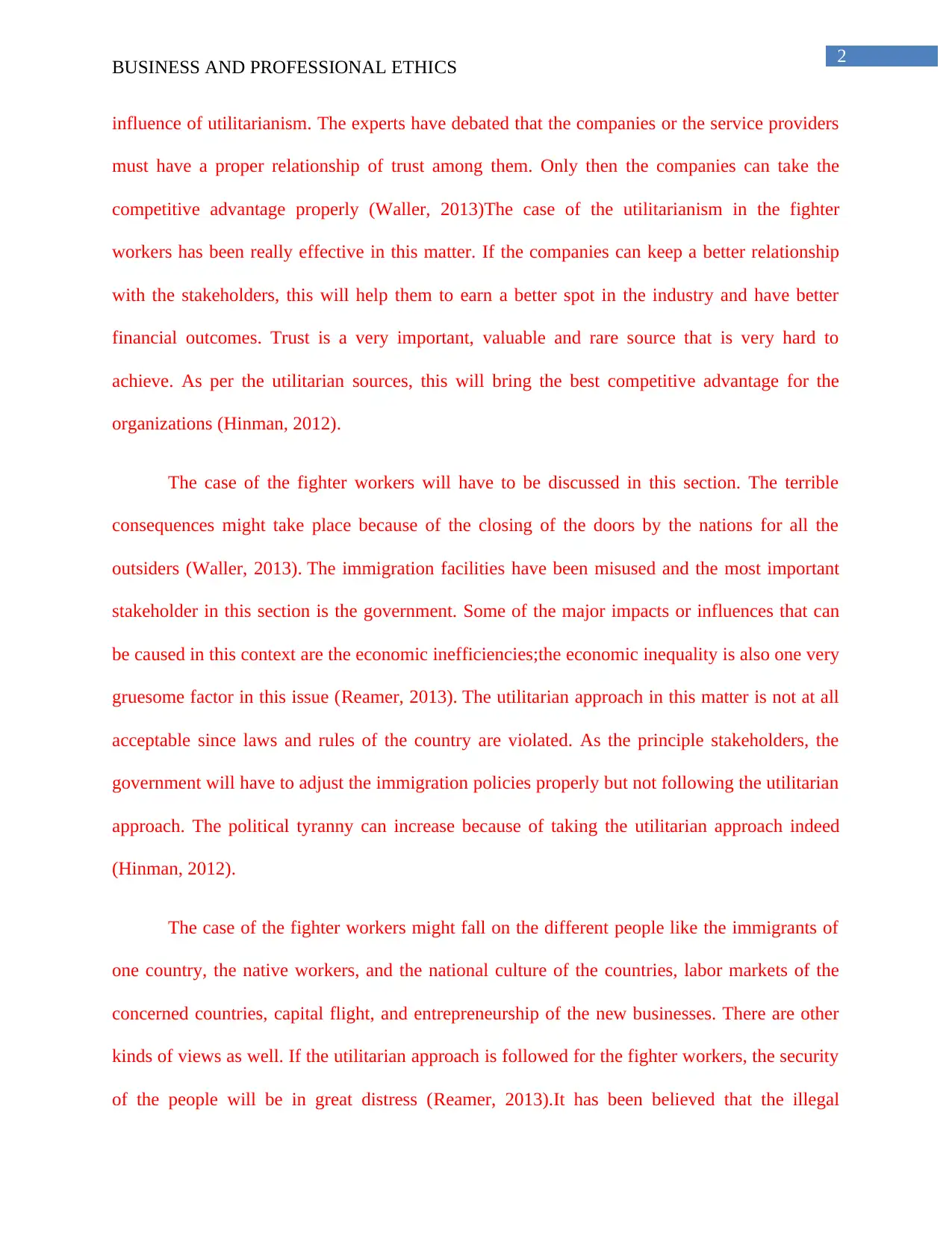
2
BUSINESS AND PROFESSIONAL ETHICS
influence of utilitarianism. The experts have debated that the companies or the service providers
must have a proper relationship of trust among them. Only then the companies can take the
competitive advantage properly (Waller, 2013)The case of the utilitarianism in the fighter
workers has been really effective in this matter. If the companies can keep a better relationship
with the stakeholders, this will help them to earn a better spot in the industry and have better
financial outcomes. Trust is a very important, valuable and rare source that is very hard to
achieve. As per the utilitarian sources, this will bring the best competitive advantage for the
organizations (Hinman, 2012).
The case of the fighter workers will have to be discussed in this section. The terrible
consequences might take place because of the closing of the doors by the nations for all the
outsiders (Waller, 2013). The immigration facilities have been misused and the most important
stakeholder in this section is the government. Some of the major impacts or influences that can
be caused in this context are the economic inefficiencies;the economic inequality is also one very
gruesome factor in this issue (Reamer, 2013). The utilitarian approach in this matter is not at all
acceptable since laws and rules of the country are violated. As the principle stakeholders, the
government will have to adjust the immigration policies properly but not following the utilitarian
approach. The political tyranny can increase because of taking the utilitarian approach indeed
(Hinman, 2012).
The case of the fighter workers might fall on the different people like the immigrants of
one country, the native workers, and the national culture of the countries, labor markets of the
concerned countries, capital flight, and entrepreneurship of the new businesses. There are other
kinds of views as well. If the utilitarian approach is followed for the fighter workers, the security
of the people will be in great distress (Reamer, 2013).It has been believed that the illegal
BUSINESS AND PROFESSIONAL ETHICS
influence of utilitarianism. The experts have debated that the companies or the service providers
must have a proper relationship of trust among them. Only then the companies can take the
competitive advantage properly (Waller, 2013)The case of the utilitarianism in the fighter
workers has been really effective in this matter. If the companies can keep a better relationship
with the stakeholders, this will help them to earn a better spot in the industry and have better
financial outcomes. Trust is a very important, valuable and rare source that is very hard to
achieve. As per the utilitarian sources, this will bring the best competitive advantage for the
organizations (Hinman, 2012).
The case of the fighter workers will have to be discussed in this section. The terrible
consequences might take place because of the closing of the doors by the nations for all the
outsiders (Waller, 2013). The immigration facilities have been misused and the most important
stakeholder in this section is the government. Some of the major impacts or influences that can
be caused in this context are the economic inefficiencies;the economic inequality is also one very
gruesome factor in this issue (Reamer, 2013). The utilitarian approach in this matter is not at all
acceptable since laws and rules of the country are violated. As the principle stakeholders, the
government will have to adjust the immigration policies properly but not following the utilitarian
approach. The political tyranny can increase because of taking the utilitarian approach indeed
(Hinman, 2012).
The case of the fighter workers might fall on the different people like the immigrants of
one country, the native workers, and the national culture of the countries, labor markets of the
concerned countries, capital flight, and entrepreneurship of the new businesses. There are other
kinds of views as well. If the utilitarian approach is followed for the fighter workers, the security
of the people will be in great distress (Reamer, 2013).It has been believed that the illegal
⊘ This is a preview!⊘
Do you want full access?
Subscribe today to unlock all pages.

Trusted by 1+ million students worldwide
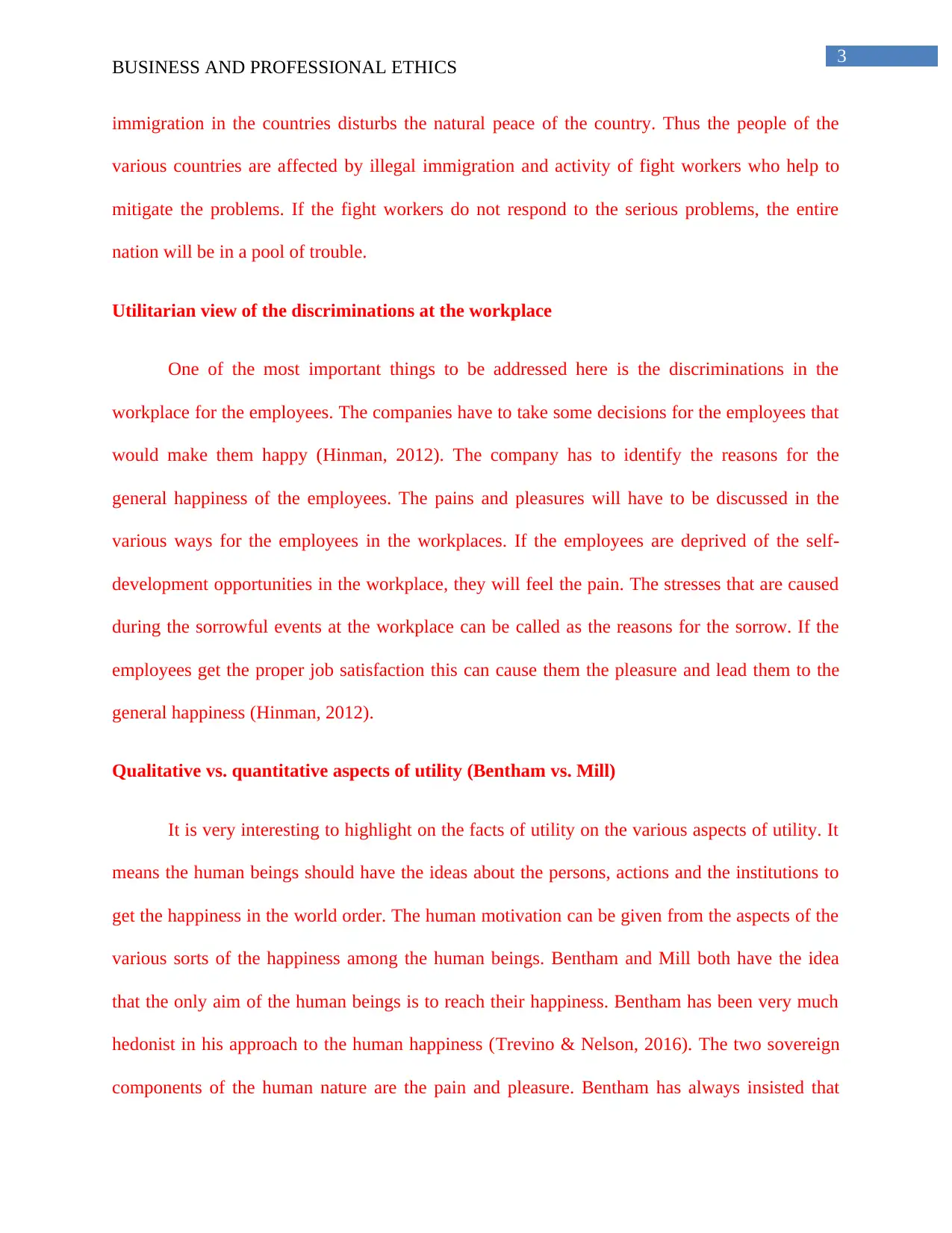
3
BUSINESS AND PROFESSIONAL ETHICS
immigration in the countries disturbs the natural peace of the country. Thus the people of the
various countries are affected by illegal immigration and activity of fight workers who help to
mitigate the problems. If the fight workers do not respond to the serious problems, the entire
nation will be in a pool of trouble.
Utilitarian view of the discriminations at the workplace
One of the most important things to be addressed here is the discriminations in the
workplace for the employees. The companies have to take some decisions for the employees that
would make them happy (Hinman, 2012). The company has to identify the reasons for the
general happiness of the employees. The pains and pleasures will have to be discussed in the
various ways for the employees in the workplaces. If the employees are deprived of the self-
development opportunities in the workplace, they will feel the pain. The stresses that are caused
during the sorrowful events at the workplace can be called as the reasons for the sorrow. If the
employees get the proper job satisfaction this can cause them the pleasure and lead them to the
general happiness (Hinman, 2012).
Qualitative vs. quantitative aspects of utility (Bentham vs. Mill)
It is very interesting to highlight on the facts of utility on the various aspects of utility. It
means the human beings should have the ideas about the persons, actions and the institutions to
get the happiness in the world order. The human motivation can be given from the aspects of the
various sorts of the happiness among the human beings. Bentham and Mill both have the idea
that the only aim of the human beings is to reach their happiness. Bentham has been very much
hedonist in his approach to the human happiness (Trevino & Nelson, 2016). The two sovereign
components of the human nature are the pain and pleasure. Bentham has always insisted that
BUSINESS AND PROFESSIONAL ETHICS
immigration in the countries disturbs the natural peace of the country. Thus the people of the
various countries are affected by illegal immigration and activity of fight workers who help to
mitigate the problems. If the fight workers do not respond to the serious problems, the entire
nation will be in a pool of trouble.
Utilitarian view of the discriminations at the workplace
One of the most important things to be addressed here is the discriminations in the
workplace for the employees. The companies have to take some decisions for the employees that
would make them happy (Hinman, 2012). The company has to identify the reasons for the
general happiness of the employees. The pains and pleasures will have to be discussed in the
various ways for the employees in the workplaces. If the employees are deprived of the self-
development opportunities in the workplace, they will feel the pain. The stresses that are caused
during the sorrowful events at the workplace can be called as the reasons for the sorrow. If the
employees get the proper job satisfaction this can cause them the pleasure and lead them to the
general happiness (Hinman, 2012).
Qualitative vs. quantitative aspects of utility (Bentham vs. Mill)
It is very interesting to highlight on the facts of utility on the various aspects of utility. It
means the human beings should have the ideas about the persons, actions and the institutions to
get the happiness in the world order. The human motivation can be given from the aspects of the
various sorts of the happiness among the human beings. Bentham and Mill both have the idea
that the only aim of the human beings is to reach their happiness. Bentham has been very much
hedonist in his approach to the human happiness (Trevino & Nelson, 2016). The two sovereign
components of the human nature are the pain and pleasure. Bentham has always insisted that
Paraphrase This Document
Need a fresh take? Get an instant paraphrase of this document with our AI Paraphraser
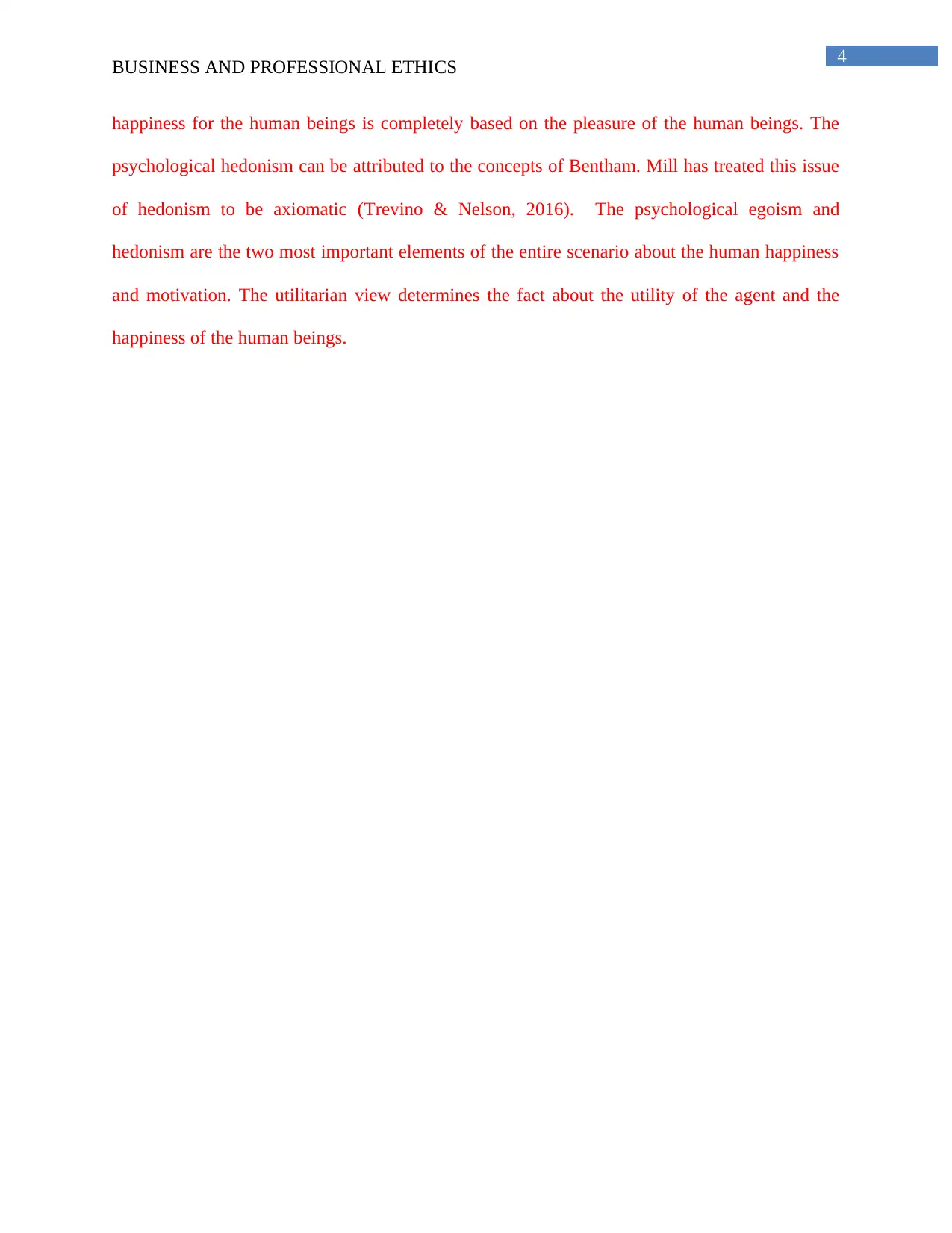
4
BUSINESS AND PROFESSIONAL ETHICS
happiness for the human beings is completely based on the pleasure of the human beings. The
psychological hedonism can be attributed to the concepts of Bentham. Mill has treated this issue
of hedonism to be axiomatic (Trevino & Nelson, 2016). The psychological egoism and
hedonism are the two most important elements of the entire scenario about the human happiness
and motivation. The utilitarian view determines the fact about the utility of the agent and the
happiness of the human beings.
BUSINESS AND PROFESSIONAL ETHICS
happiness for the human beings is completely based on the pleasure of the human beings. The
psychological hedonism can be attributed to the concepts of Bentham. Mill has treated this issue
of hedonism to be axiomatic (Trevino & Nelson, 2016). The psychological egoism and
hedonism are the two most important elements of the entire scenario about the human happiness
and motivation. The utilitarian view determines the fact about the utility of the agent and the
happiness of the human beings.
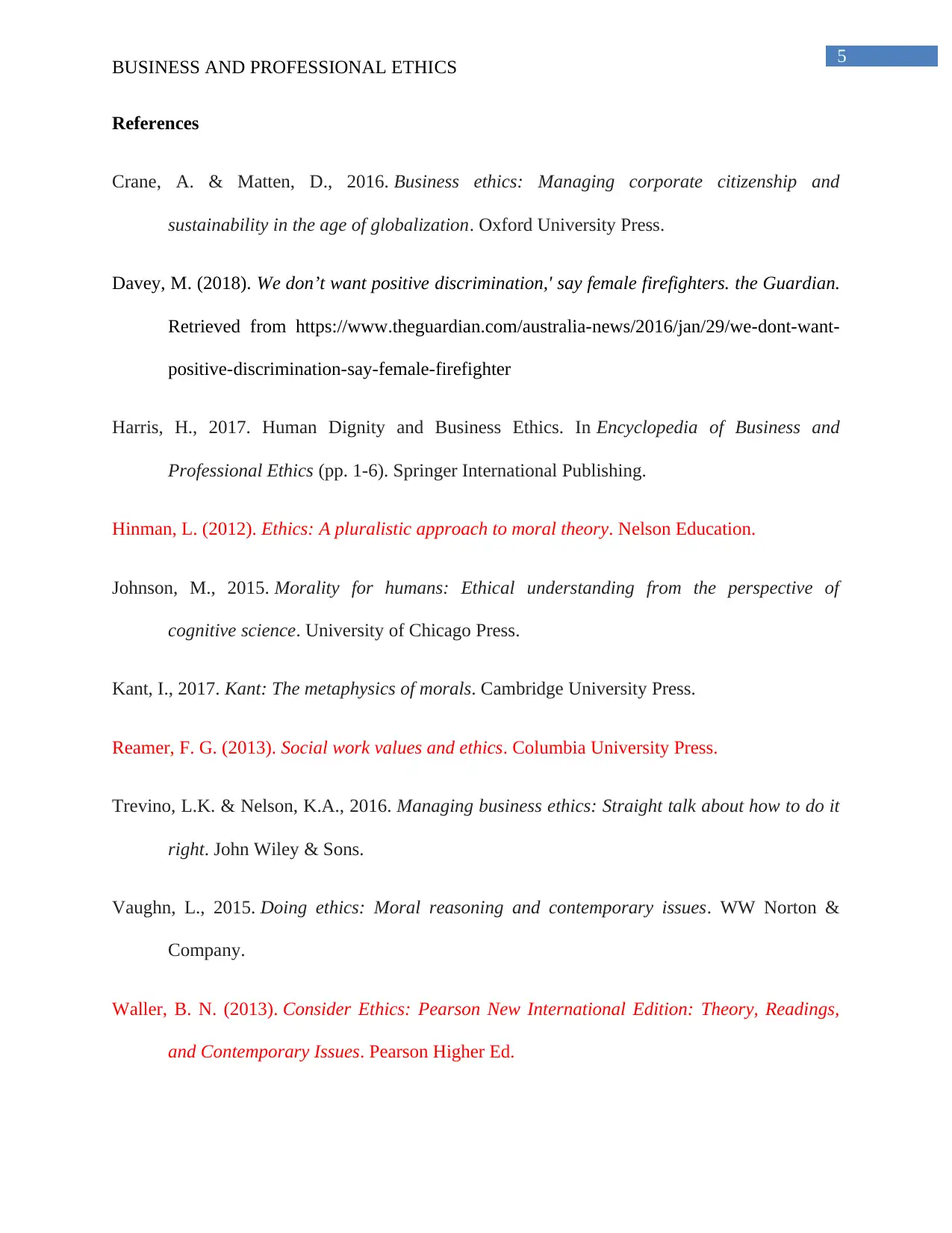
5
BUSINESS AND PROFESSIONAL ETHICS
References
Crane, A. & Matten, D., 2016. Business ethics: Managing corporate citizenship and
sustainability in the age of globalization. Oxford University Press.
Davey, M. (2018). We don’t want positive discrimination,' say female firefighters. the Guardian.
Retrieved from https://www.theguardian.com/australia-news/2016/jan/29/we-dont-want-
positive-discrimination-say-female-firefighter
Harris, H., 2017. Human Dignity and Business Ethics. In Encyclopedia of Business and
Professional Ethics (pp. 1-6). Springer International Publishing.
Hinman, L. (2012). Ethics: A pluralistic approach to moral theory. Nelson Education.
Johnson, M., 2015. Morality for humans: Ethical understanding from the perspective of
cognitive science. University of Chicago Press.
Kant, I., 2017. Kant: The metaphysics of morals. Cambridge University Press.
Reamer, F. G. (2013). Social work values and ethics. Columbia University Press.
Trevino, L.K. & Nelson, K.A., 2016. Managing business ethics: Straight talk about how to do it
right. John Wiley & Sons.
Vaughn, L., 2015. Doing ethics: Moral reasoning and contemporary issues. WW Norton &
Company.
Waller, B. N. (2013). Consider Ethics: Pearson New International Edition: Theory, Readings,
and Contemporary Issues. Pearson Higher Ed.
BUSINESS AND PROFESSIONAL ETHICS
References
Crane, A. & Matten, D., 2016. Business ethics: Managing corporate citizenship and
sustainability in the age of globalization. Oxford University Press.
Davey, M. (2018). We don’t want positive discrimination,' say female firefighters. the Guardian.
Retrieved from https://www.theguardian.com/australia-news/2016/jan/29/we-dont-want-
positive-discrimination-say-female-firefighter
Harris, H., 2017. Human Dignity and Business Ethics. In Encyclopedia of Business and
Professional Ethics (pp. 1-6). Springer International Publishing.
Hinman, L. (2012). Ethics: A pluralistic approach to moral theory. Nelson Education.
Johnson, M., 2015. Morality for humans: Ethical understanding from the perspective of
cognitive science. University of Chicago Press.
Kant, I., 2017. Kant: The metaphysics of morals. Cambridge University Press.
Reamer, F. G. (2013). Social work values and ethics. Columbia University Press.
Trevino, L.K. & Nelson, K.A., 2016. Managing business ethics: Straight talk about how to do it
right. John Wiley & Sons.
Vaughn, L., 2015. Doing ethics: Moral reasoning and contemporary issues. WW Norton &
Company.
Waller, B. N. (2013). Consider Ethics: Pearson New International Edition: Theory, Readings,
and Contemporary Issues. Pearson Higher Ed.
⊘ This is a preview!⊘
Do you want full access?
Subscribe today to unlock all pages.

Trusted by 1+ million students worldwide
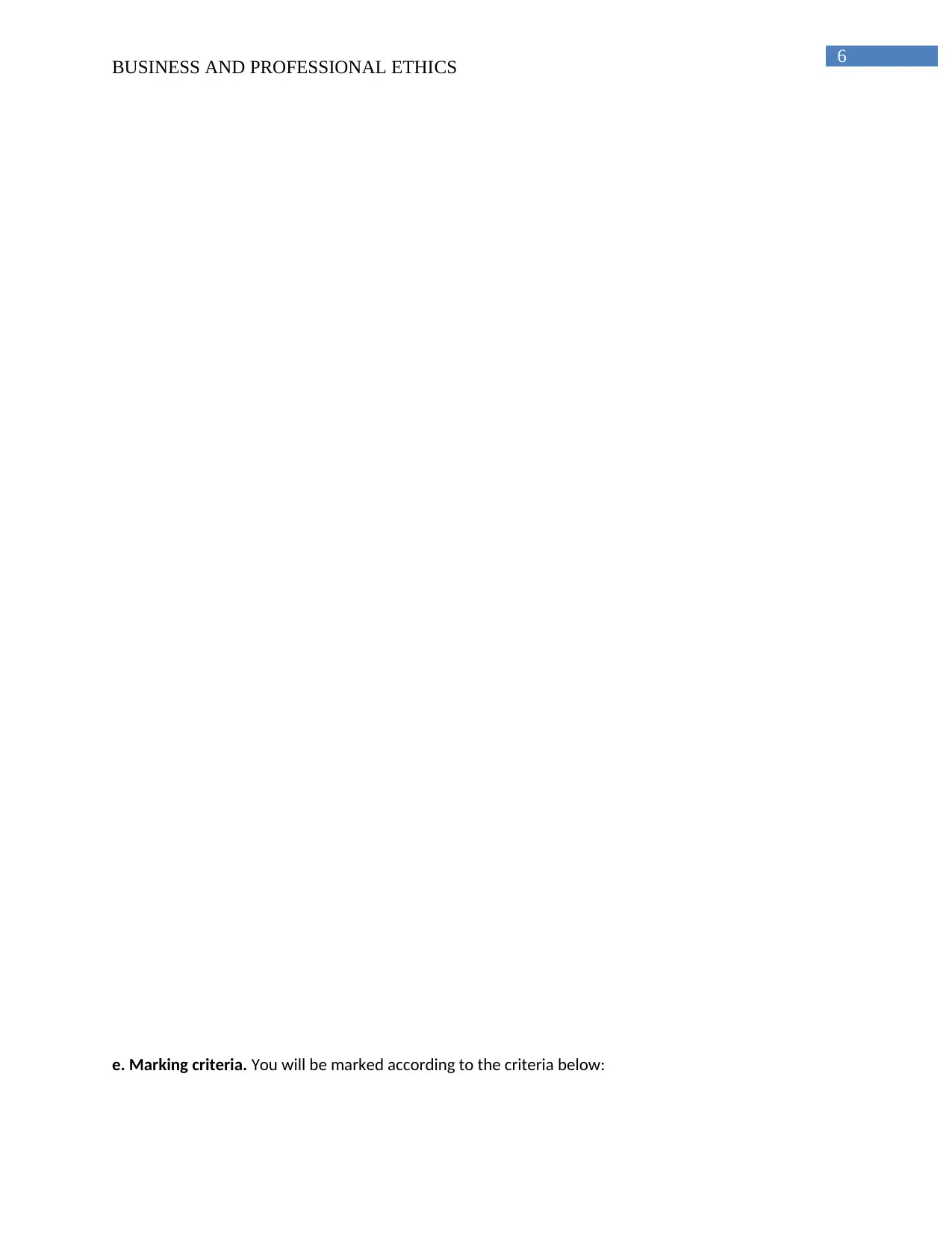
6
BUSINESS AND PROFESSIONAL ETHICS
e. Marking criteria. You will be marked according to the criteria below:
BUSINESS AND PROFESSIONAL ETHICS
e. Marking criteria. You will be marked according to the criteria below:
Paraphrase This Document
Need a fresh take? Get an instant paraphrase of this document with our AI Paraphraser
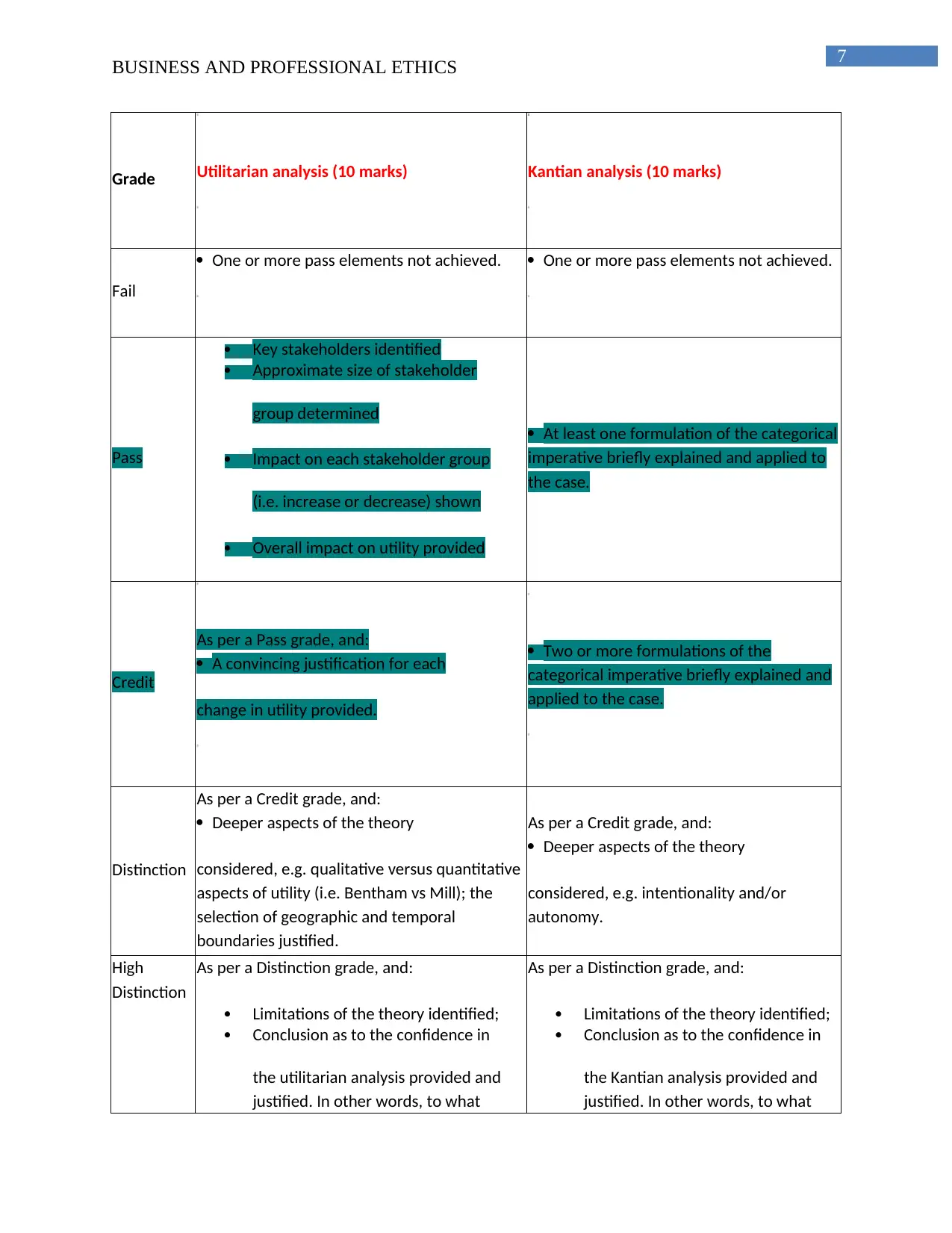
7
BUSINESS AND PROFESSIONAL ETHICS
Grade Utilitarian analysis (10 marks) Kantian analysis (10 marks)
Fail
One or more pass elements not achieved. One or more pass elements not achieved.
Pass
Key stakeholders identified
Approximate size of stakeholder
group determined
Impact on each stakeholder group
(i.e. increase or decrease) shown
Overall impact on utility provided
At least one formulation of the categorical
imperative briefly explained and applied to
the case.
Credit
As per a Pass grade, and:
A convincing justification for each
change in utility provided.
Two or more formulations of the
categorical imperative briefly explained and
applied to the case.
Distinction
As per a Credit grade, and:
Deeper aspects of the theory
considered, e.g. qualitative versus quantitative
aspects of utility (i.e. Bentham vs Mill); the
selection of geographic and temporal
boundaries justified.
As per a Credit grade, and:
Deeper aspects of the theory
considered, e.g. intentionality and/or
autonomy.
High
Distinction
As per a Distinction grade, and:
Limitations of the theory identified;
Conclusion as to the confidence in
the utilitarian analysis provided and
justified. In other words, to what
As per a Distinction grade, and:
Limitations of the theory identified;
Conclusion as to the confidence in
the Kantian analysis provided and
justified. In other words, to what
BUSINESS AND PROFESSIONAL ETHICS
Grade Utilitarian analysis (10 marks) Kantian analysis (10 marks)
Fail
One or more pass elements not achieved. One or more pass elements not achieved.
Pass
Key stakeholders identified
Approximate size of stakeholder
group determined
Impact on each stakeholder group
(i.e. increase or decrease) shown
Overall impact on utility provided
At least one formulation of the categorical
imperative briefly explained and applied to
the case.
Credit
As per a Pass grade, and:
A convincing justification for each
change in utility provided.
Two or more formulations of the
categorical imperative briefly explained and
applied to the case.
Distinction
As per a Credit grade, and:
Deeper aspects of the theory
considered, e.g. qualitative versus quantitative
aspects of utility (i.e. Bentham vs Mill); the
selection of geographic and temporal
boundaries justified.
As per a Credit grade, and:
Deeper aspects of the theory
considered, e.g. intentionality and/or
autonomy.
High
Distinction
As per a Distinction grade, and:
Limitations of the theory identified;
Conclusion as to the confidence in
the utilitarian analysis provided and
justified. In other words, to what
As per a Distinction grade, and:
Limitations of the theory identified;
Conclusion as to the confidence in
the Kantian analysis provided and
justified. In other words, to what
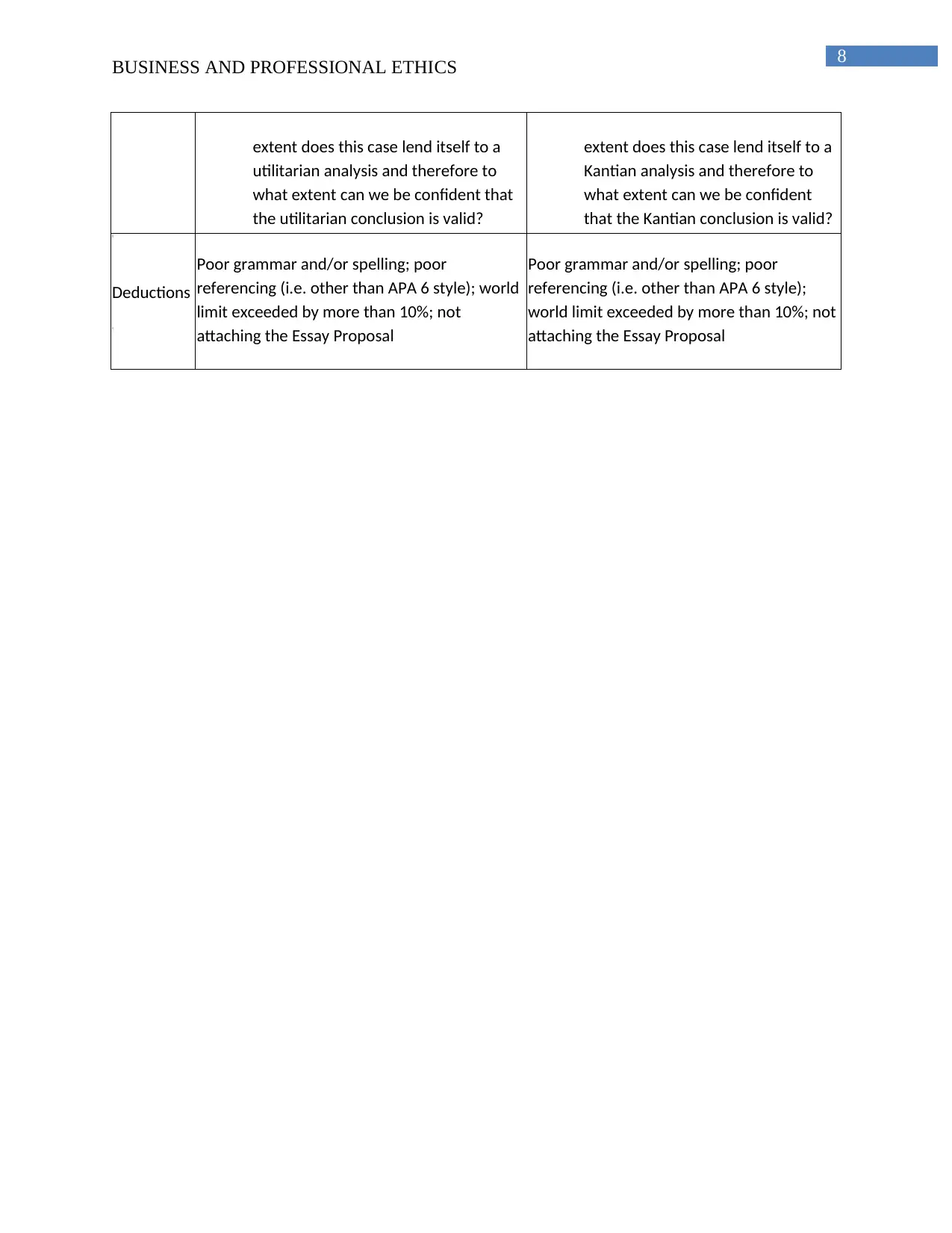
8
BUSINESS AND PROFESSIONAL ETHICS
extent does this case lend itself to a
utilitarian analysis and therefore to
what extent can we be confident that
the utilitarian conclusion is valid?
extent does this case lend itself to a
Kantian analysis and therefore to
what extent can we be confident
that the Kantian conclusion is valid?
Deductions
Poor grammar and/or spelling; poor
referencing (i.e. other than APA 6 style); world
limit exceeded by more than 10%; not
attaching the Essay Proposal
Poor grammar and/or spelling; poor
referencing (i.e. other than APA 6 style);
world limit exceeded by more than 10%; not
attaching the Essay Proposal
BUSINESS AND PROFESSIONAL ETHICS
extent does this case lend itself to a
utilitarian analysis and therefore to
what extent can we be confident that
the utilitarian conclusion is valid?
extent does this case lend itself to a
Kantian analysis and therefore to
what extent can we be confident
that the Kantian conclusion is valid?
Deductions
Poor grammar and/or spelling; poor
referencing (i.e. other than APA 6 style); world
limit exceeded by more than 10%; not
attaching the Essay Proposal
Poor grammar and/or spelling; poor
referencing (i.e. other than APA 6 style);
world limit exceeded by more than 10%; not
attaching the Essay Proposal
⊘ This is a preview!⊘
Do you want full access?
Subscribe today to unlock all pages.

Trusted by 1+ million students worldwide
1 out of 9
Related Documents
Your All-in-One AI-Powered Toolkit for Academic Success.
+13062052269
info@desklib.com
Available 24*7 on WhatsApp / Email
![[object Object]](/_next/static/media/star-bottom.7253800d.svg)
Unlock your academic potential
Copyright © 2020–2025 A2Z Services. All Rights Reserved. Developed and managed by ZUCOL.





